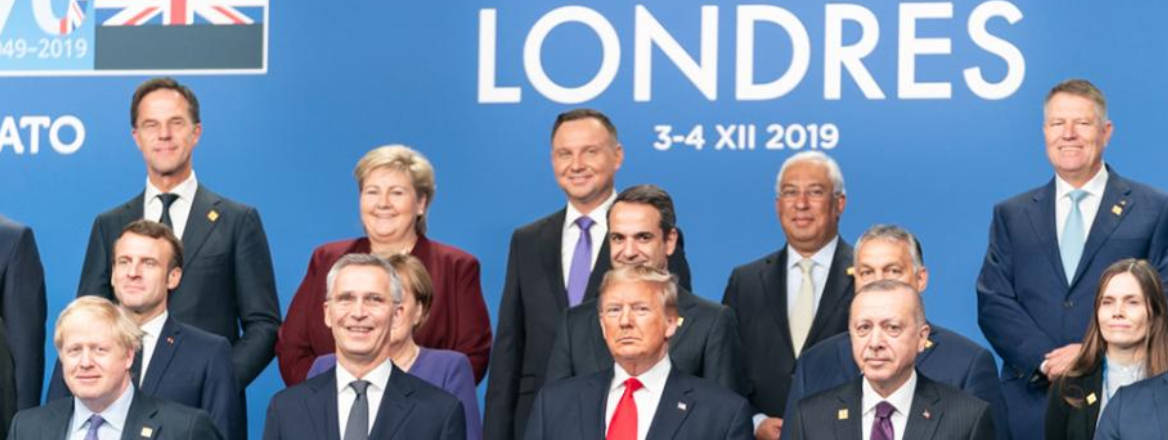NATO’s Secretary General recently outlined an inspiring vision of a revamped Alliance by the end of the decade – it will not be easy to achieve.
Amidst the national angst around the coronavirus pandemic response, the speech by NATO Secretary General Jens Stoltenberg on 8 June 2020 did not make headlines – perhaps it should have done.
In outlining his vision for NATO in 2030, Stoltenberg focused on increasing the political and economic unity and impact of the Alliance, and doing so globally, rather than simply in a European or North Atlantic context. Such language is exactly what the US was lobbying for at the leaders’ meeting in London in December 2019: a refocusing and appreciation of the role China has been playing in global security challenges. This is a bold plan in the face of various European economic tie-ins with China. It also comes at an opportune moment, as President Donald Trump has ordered the withdrawal of more US troops from European soil, a move which has been met with unusual criticism from European politicians and former US military staff.
New Military Goalposts
Whilst Stoltenberg focused on political unity and the potential economic levers of a united Alliance, there are a number of military changes that are being developed and reviewed over this summer. The new NATO military strategy achieved approval in May 2019 and SACEUR (NATO’s senior warfighting commander) is drafting a new Operational Concept of Deterrence and Defence and a new NATO Warfighting Capability Concept is also in the works.
These plans are perhaps an attempt to shift the Alliance’s military planning from one that is capability-based (a concept that tries to have a smattering of every military capability available, including some new ones), to one that is threat-based (a concept that looks specifically at competitors and builds/develops capabilities designed to counteract any weaknesses and build on opportunities for advantage).
Currently, NATO is driven by the equipment states have determined they need (or wish to retain), and will make available to NATO. The new concept would prioritise and presumably encourage states to change their priorities in favour of those the Alliance determines as important. What is difficult to imagine is how SACEUR will reconcile the ability to generate these forces with national prioritisation and deployment of forces by individual states: this is a fundamental dilemma that will need to be overcome if the concepts are to be useful.
The Trade-offs for Member States
For individual member states, this will lead to some tough choices, and questions over the prioritisation of investment decisions. If, for example, the UK decided – in its paused Integrated Review – to move away from heavy-armour formations in favour of lighter and more manoeuvrable forces, this impacts on any NATO plan for a heavy deterrence capability to match that of Russia. The implication is that decisions will need to determine whether NATO is actually important enough to skew internal, sovereign policy decisions, or whether a balance can be struck.
Across the Alliance, striking that balance is a dilemma that can become divisive, as some members step up to the fighting part of the requirement, whilst others focus on the high-tech (but much safer) part. The relative investments might be equal in national treasure, but the difference in risk to personnel will be significant.
Should the UK make unilateral decisions (for example on potentially scrapping the Army’s heavy-armoured capability), it will be tempting for the government to argue that the additional capabilities of British Carrier Strike capability, or large numbers of F35s, drones, or new surveillance capabilities, along with a healthy research and development financial allocation, outweigh the potential drawbacks from the removal of tanks from its commitment to NATO’s Order of Battle. The reality, however, is that those new capabilities will not buy out that commitment of a heavy armour formation in the land domain, specifically aimed at countering Russian armoured strength. A NATO threat-based model of force design and employment is realistic and desirable in the current competition against Russia, but cannot be achieved unless member states also adopt the same concept. A divergence in the philosophy of force designs between member states and NATO will mean that the Alliance can generate neither a capability-based force, nor one that matches the threat, leaving the organisation in a worse position than it is already.
Argue, Cajole and Argue Again
If Stoltenberg is serious about making these military changes, as well as the political and economic ones, he will need to make a more convincing argument to major contributors (the US, France, the UK, and Germany) that their defence budgets and procurement plans need to be NATO-centric, and not merely where national defence plans conveniently coincide with NATO’s. The speed of development of these states is much faster than many other Alliance member states can afford, or have planned for. Yet more transformation might be needed, and there is the risk of developing a three-speed NATO, with the staggering pace of US military development, the slower pace of similar trends in the UK, France and potentially Germany, and the more measured speed of other Allies, which will be largely determined by broad national economic trends and budget allocations.
Making a compelling case for reform to NATO’s Defence Planning will be increasingly difficult as rumours abound of European states cutting military spending to pay for their response to the coronavirus pandemic and the havoc this has inflicted on national finances. The expectation over this summer is that several NATO member states may formally announce their failure to meet the spending ambition of 2% of GDP on defence equipment. Deep reform within states (on prioritising NATO capability requirements over national desires, and maintaining spending levels to deliver deployable forces with high utility), and within NATO (in developing coherent and credible plans that guarantee NATO support to states where their own military capabilities do not cover every eventuality), is certainly possible. If allies can grasp the opportunity that reform offers, NATO could benefit, but the alliance has historically not been good at moving fast in this space.
No doubt, added complications will arise from the announced US withdrawal of more forces from Europe. In Germany, the unilateral decision by President Trump leaves Chancellor Angela Merkel in a difficult position: under increasing pressure to work with France on the ambiguous concept of European Strategic Autonomy (under an EU banner), but still requiring enduring and practical NATO security guarantees in the long term.
Stoltenberg’s speech was full of ambition and aspiration, arguably a much-needed shot in the arm for NATO, which has performed admirably during the pandemic response (and certainly fared better than the EU).
Yet the reality of delivery will prove to be a more difficult task.
The views expressed in this Commentary are the author's, and do not represent those of RUSI or any other institution.
WRITTEN BY
Professor Peter Roberts
RUSI Senior Associate Fellow, Military Sciences


